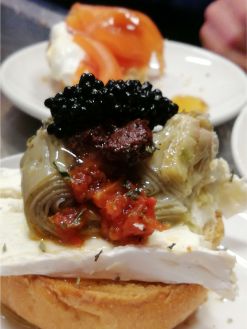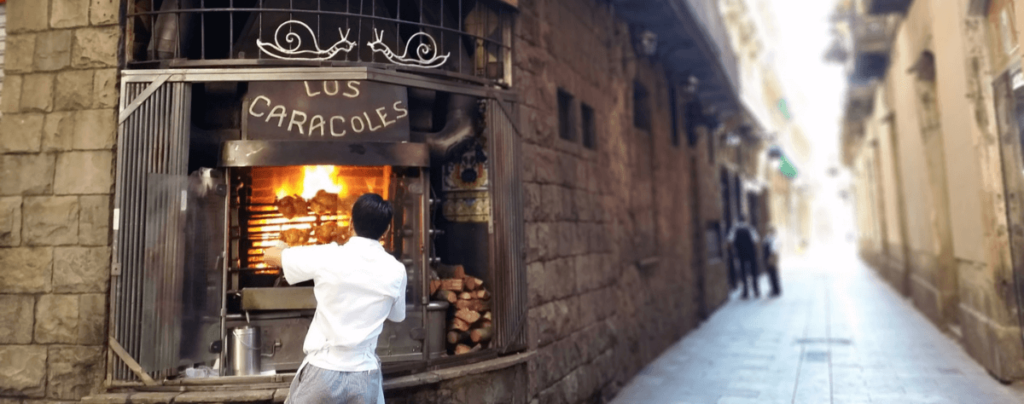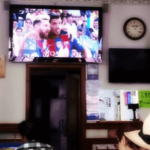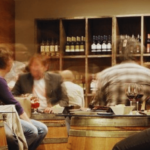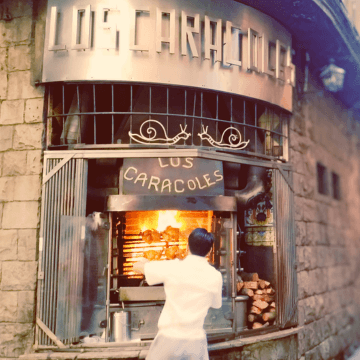
100 Years Old Restaurants in Barcelona (and older)
DISCOVER THE OLDEST RESTAURANTS IN BARCELONA
When I thought about writing a post about old restaurants in Barcelona I thought it was going to be a short and sweet post… Until I realized how many old food venues are in town! Then I started considering: should I only talk about restaurants? What about tapas bars, do they count? But then, there’s some really cool old historical drink bars worth mentioning… And if I talk about them, then it’ wouldn’t be fair to leave cafes out!
So I decided I was going to focus on restaurants, but I’d also briefly mention the rest. And eventually I had to decide to stop listing the venues from 1920 and older. That was sad, I had to leave out some of my favorites! But otherwise the list would have been never-ending. So… Enjoy!
The oldest: restaurants from the 1700's
1
Can Ramonet, since 1753
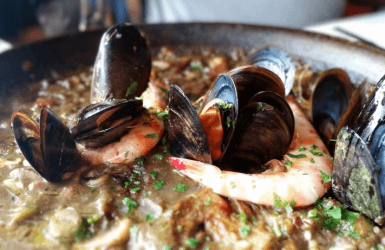
Can Ramonet started out as a small wine cellar in 1753 that sold wine in bulk from barrels, eventually becoming a tabern that served food to the local fishermen. The building is still the original, one of the first to be built in La Barceloneta. But it wouldn't be until 1956 that it became the Can Ramonet as we know it now. They serve paella and other fish rice dishes, seafood and tapas, some of their recipes passed down from grandma Ramona.
ADDRESS: C/ de la Maquinista, 17
DISTRICT: Barceloneta
SEE REVIEWS AND BOOK A TABLE >>
2
Can Culleretes, since 1786
ADDRESS: C/ d’en Quintana, 5
DISTRICT: Gothic Quarter
SEE REVIEWS AND BOOK A TABLE >>
Very old: bars and restaurants from the 1800's
3
Los Caracoles, since 1835
Founded by the Bofarull family, originally with the name Can Bofarull (“At the Bofarull’s”, in Catalan), it is nowadays run by the 5th generation of the same family. In 1915 the restaurant was renamed after one of its most popular dishes: escargots. In 1934 they installed their iconic open grill facing the street corner. Since then it became a favorite of the local high society of the time, and later on of politicians, artists and celebrities such as the USA President Jimmy Carter, Charlton heston, Lenny Kravitz, Robert De Niro, Giorgio Armani or Salvador Dali.
ADDRESS: C/ Escudellers, 14
DISTRICT: Gothic Quarter
SEE REVIEWS AND BOOK A TABLE >>
4
7 Portes, since 1836
ADDRESS: Passeig Isabel II, 14
DISTRICT: Barceloneta
SEE REVIEWS AND BOOK A TABLE >>
5
Antic Cafe Espanyol, since 1895
In the late 1800’s, the Avinguda Paral·lel street was the Barcelona version of Broadway and the Parisian Montmartre. There were theaters, cabarets, dance halls, cafés… Josep Caraben, aka Pepito, open a small cafe next to a circus. And after the circus venue was destroyed in a fire in 1907, Mr. Pepito purchased half of the circus state to expand his business. The Cafe Español became the largest cafe in Spain, and in its basement they featured 50 pool tables.
The Cafe became a meeting point for artists, intellectuals and politicians of all inclinations. Mr. Pepito welcomed everyone as long as they respected each other. Unfortunately, with the decades the vibe of the district died away, and so the Cafe lost its popularity. Nowadays a modern (and smaller) restaurant continues to exist despite having lost the charm of the original historical restaurant.
ADDRESS: Avinguda Paral·lel, 64
DISTRICT: Edge of the Raval district
SEE REVIEWS AND BOOK A TABLE >>
6
4 Gats, since 1897
Outside of meal times it’s open as a cafe, and during lunch and dinner you’ll find here well elaborated Catalan cuisine with occasional French and Italian touches. And at night there’s live music, usually piano.
ADDRESS: C/ Montsio, 3
DISTRICT: Gothic Quarter
SEE REVIEWS AND BOOK A TABLE >>
7
Tapas bars in venues from the 1800's
- Bodega Salvat (1880, Sants district). Good old neighborhood bar with good beers and vermouth, and famous for its anchovies. A bit run-down look, with worn tiles, slot machines and soccer parafernalia hanging in the walls.
- La Pubilla del Taulat (1886, Poblenou district). Old-fashioned wine shop with a tiny tapas bar that serves classic tapas.
- Bodega Marin (1896, Gracia district). Wine shop with a gourmet tapas bar.
8
Drink bars from the 1800's
- Bar Marsella (1820, Raval district). Considered the oldest drink bar in Barcelona, Picasso and Hemingway came here to drink absinthe.
- Casa Almirall (1860, Raval district). Also an absinthe bar, although less louder than Marsella, and with a more elegant decoration.
- Bar Raïm (1886, Gracia). The former cafeteria of a factory became a Cuban bar in 2022, but the original decoration was preserved. Only the food and the music reveal the origins of the current owners.
- Barra & Art (1886, La Rambla). Originally a deli shop called Can Mumbru, it featured delicious modernist decoration that was respected when it became a fast-food venue in 1989, then the current Barra & Art tapas and cocktails bar.
- Lennox (1893, Gothic Quarter). An Irish pub and sports bar that occupies the venue of a modernist deli shop. Most of the decoration is still original.
9
1800's cafés
- Escribà – Antiga Casa Figueras (1820, La Rambla). A flour and pasta shop from the 1800’s, renovated in 1902 in Modernist style and turned into a cake store and cafe in 1906.
- Granja Viader (1840, Raval district). Cafe specialised in dairy products and great for hot chocolate, whipped cream. Here was created the popular brand of chocolate shakes “Cacaolat”.
- Pastisseria Brunells (1852, Born district). A cake shop winner of the award to the best croissant in Spain. While the cake shop is the only part of the business that preserves its 1800’s decoration, they have recently opened a cafe next door, which is why I decided to add it to this list.
Quite old: restaurants from the early 1900's
10
Restaurant of Hotel Espanya, since 1902
ADDRESS: C/ Sant Pau, 9-11
DISTRICT: Raval district
SEE REVIEWS AND BOOK A TABLE >>
11
Grill Room (Bar Thonet), since 1902
The Italian businessman Flaminio Mezzalama opened in 1902 Bar Torino, one of the first bars in Spain to serve Martini vermouth. The idea was a success and for a while a second and larger venue was open in Passeig de Gracia until it closed in 1916 and the decoration moved to the original Bar Torino in Escudellers street. Masters of the Modernism had collaborated decorating the space, including the famous chair designer Michael Thonet. The original Bar Torino became Grill Room, and in 2018, the chef Albert Ventura turned it into a gourmet tapas bar.
ADDRESS: C/ Escudellers, 8
DISTRICT: Gothic Quarter
SEE REVIEWS AND BOOK A TABLE >>
12
Can Pineda, since 1904
In 1904 was founded a cellar that sold wine in bulk from barrels to the neighbors of that (then) industrial area. When the new wine arrived from the countryside, the owners of the cellar hung a pine tree brunch over the door to announce it, hence the name of the business, “the Pinewood”. They also served simple meals to the workers of the nearby factories. But when in 1972 the business was transferred to the Cuenca and Jovells families, things changed and they started serving refined dishes inspired in the seasons as well as in imported international products. The restaurant preserves the original decoration from over a century ago.
ADDRESS: C/ Sant Joan de Malta, 55
DISTRICT: El Clot
SEE REVIEWS AND BOOK A TABLE >>
13
El Sortidor, since 1908
ADDRESS: Plaça del Sortidor, 5
DISTRICT: Poble Sec
SEE REVIEWS AND BOOK A TABLE >>
14
Casa Rafols, since 1911
During the times of the Art Nouveau and the Modernism style, even hardware stores were beautiful. And that was the case of Casa Rafols. Then when the Spanish Civil War broke out in 1936, the owners used their basement as a clandestine restaurant. Nowadays the hardware store has become a tapas and Spanish food restaurant, the workshop has become a piano bar, and the basement is a jazz club.
ADDRESS: C/ Ronda de Sant Pere, 74
DISTRICT: Eixample
SEE REVIEWS AND BOOK A TABLE >>
15
Tapas bars in venues from the early 1900s
- Bar Vasconia (1905, Gothic Quarter). Popular neighborhood bar with marble counter and old tiles serving classic tapas.
- Bar L'Electricitat (1908, Barceloneta). Sober but authentic decoration of a bar that catered the local working class, and continues to attract a local crowd. Try their Russian potato salad and the bomba (a ball of mashed potatoes with a meat core).
- Bar Borrell (1909, where Sant Antoni, Poble-Sec and Raval meet). Decent tapas in a bar that used to be frequented by the artists that performed in the nearby theaters at the beginning of the 20th century. Plain wood panels, old radios and refrigerators and large mirrors.
- Quimet i Quimet (1914, Poble-Sec). 5 generations of the same family have run this tiny historical wine shop and bar famous for their “montaditos” (a tapa consisting of a slice of bread with a variety of toppings). You need to go, even more for the food than for the original decoration (that is there, but it’s mostly shelves filled with wine bottles for sale).
16
Drink bars from the early 1900's
- El Paraigua (1902, Gothic Quarter). Cocktail bar founded in 1967 inside a structure that used to be a nun convent in the Middle Ages, and decorated with modernist items coming from an 1900’s umbrella store. The bar counter is between two columns that used to be part of a Baroque altarpiece.
- London Bar (1910, Raval district). Famous modernist cocktail bar run by the 3rd generation of the same family. It attracts a bohemian and artist crew, and there’s often live music or circus performances.
- La Confiteria (1912, Raval district). A beautiful modernist cake shop from the early 1900’s was turned into a cocktail bar in 2014, carefully restoring the original decorative elements.
17
Early 1900's cafés
- Escribà – Antic Forn Serra (1906, Eixample). First a bakery, later on a chef when the son-in-law of the founder took over. While the decoration isn’t as mesmerizing as their shop in la Rambla, this is the company’s flagship store, where their think-tab and workshop is, and where you may see their most spectacular window displays.
- Mesón del Café (1909, Gothic Quarter). A mix of cafe and tapas bar, with dark wood decoration.
- El Tio Che (1912, Poblenou). The oldest horchata bar in Barcelona.
- Cafe Colombia (1913, Sant Andreu). Neighborhood tapas bar with some modernist decoration serving simple tapas and sandwiches.
What are your favorite old restaurants in Barcelona?
Marta
RESEARCHING FOR A TRIP IS TIME-CONSUMING…
Need more inspiration?
Our 100% FREE Barcelona Collection will give you everything you need to organize the trip of your lifetime to Barcelona.
BEST INSIDER TIPS FROM THE PROS!
